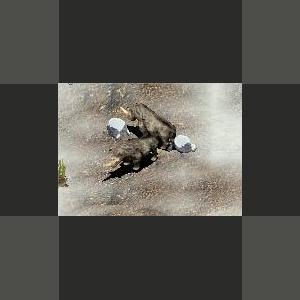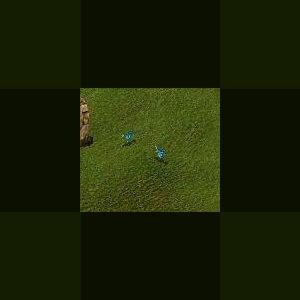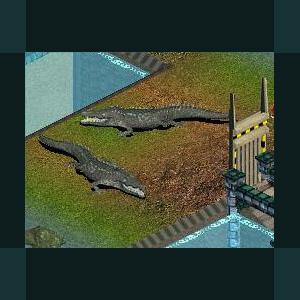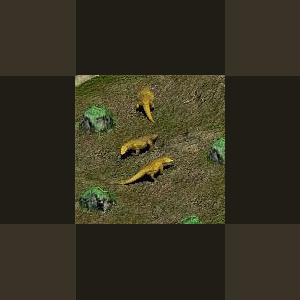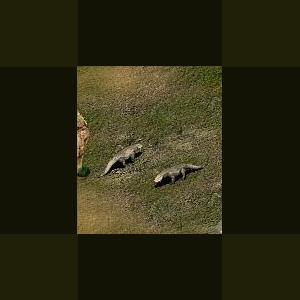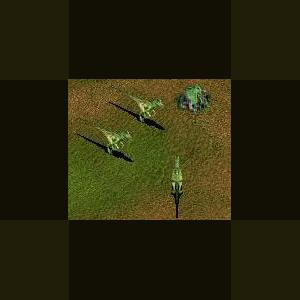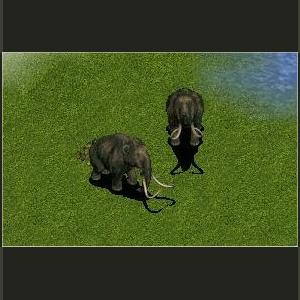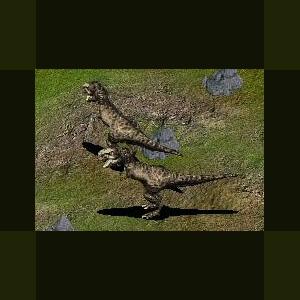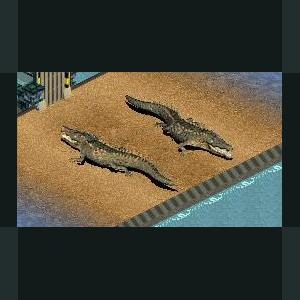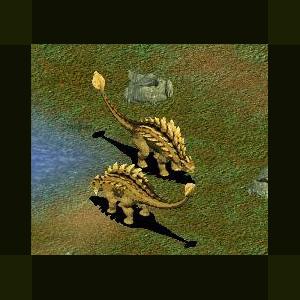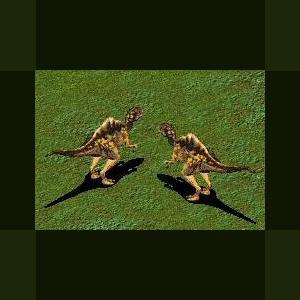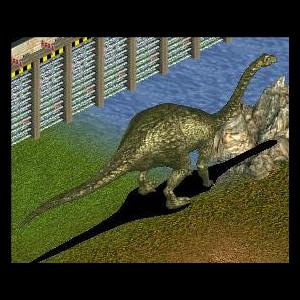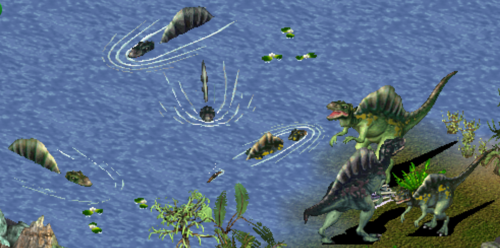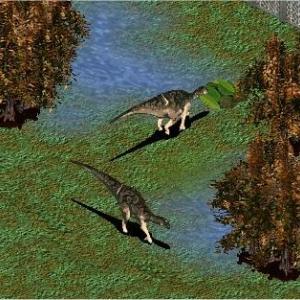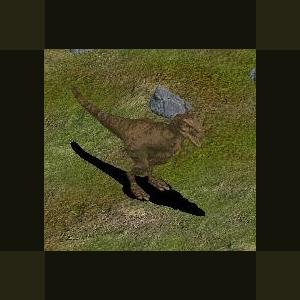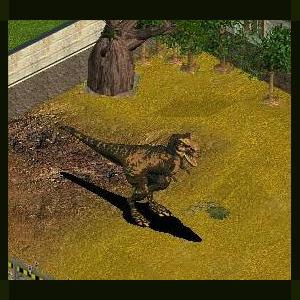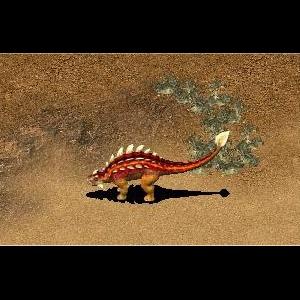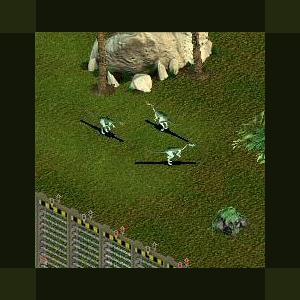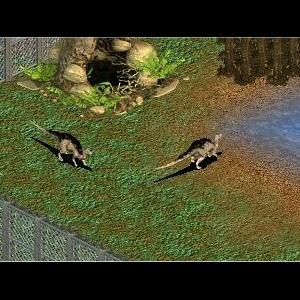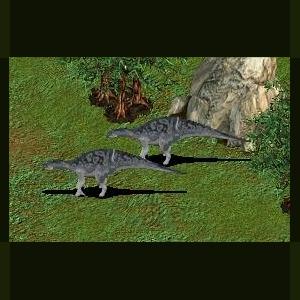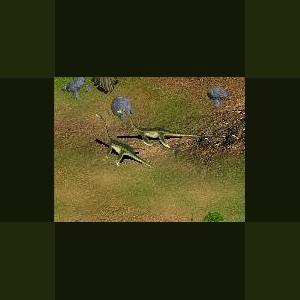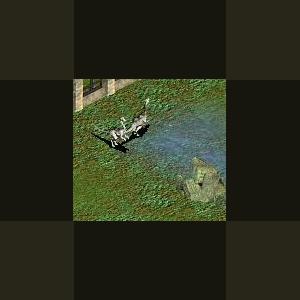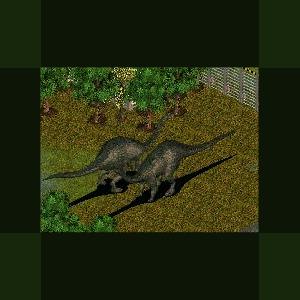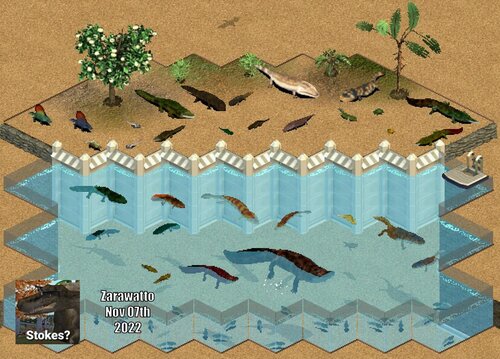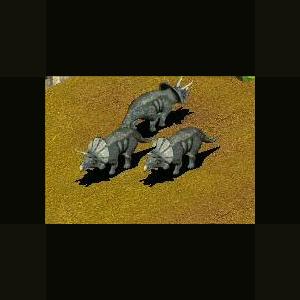Dinosaurs
Creatures from another age
241 files
-
Sinotherium by Moondawg
By Guest
Sinotherium ("Chinese Beast") was a genus of single-horned rhinoceri of the late Miocene and Pliocene.
It was ancestral to Elasmotherium, and its fossils have been found in western China. Sinotherium diverged from the ancestral genus, Iranotherium, first found in Iran, during the early Pliocene. Some experts prefer to lump Sinotherium, and Iranotherium into Elasmotherium.
260 downloads
0 comments
Updated
-
Sinovenator by Moondawg
By Guest
Sinovenator (meaning "Chinese - hunter", derived from the Latin word venator = hunter) is a genus of troodontid dinosaur from China.
It is from the early Cretaceous Period. Two fossils were found in the older (lower) portion of the Yixian Formation in China, 128.2 million years ago (Ma) during the Barremian age. The type specimen, Sinovenator changii, was described by Xu, Norell, Wang, Makovicky and Wu in 2002.
The type specimen is IVPP 12615, a partial skull and disarticulated skeleton. A referred specimen is IVPP 12583, an incomplete but articulated postcranial skeleton. Both are in the collection of the Institute of Vertebrate Paleontology and Paleoanthropology in Beijing China.
Sinovenator was a basal troodontid. It is the oldest and most basal described member of this family (older still but much more advanced is the yet undescribed WDC DML 001, from the Kimmeridgian-age Morrison Formation from United States). Sinovenator shares features with the most primitive dromaeosaurids and Avialae, demonstrating the common inheritance of these three members of the Paraves. Sinovenator was about the size of a chicken.
155 downloads
0 comments
Updated
-
Smilosuchus by Moondawg
By Guest
Smilosuchus
Smilosuchus is an extinct genus of phytosaur from the Late Triassic of North America.
The crurotarsans were a fabulous bunch of monsters. Some called phytosaurs looked and lived a lot like today's crocodiles, staying submerged in rivers or lakes until attacking a victim. The North American phytosaur Smilosuchus grew to 39 feet long.
This is probably the biggest Phytosaur known,with a length up to 12m (40 ft)rivaling some of the biggest crocodiles that ever existed.It was probably the largest land animalof the late Triassic.Usually the largest land animals are plant-eaters.In Triassic times they were meat-eaters.
198 downloads
0 comments
Updated
-
Sphagesaurus by Moondawg
By Guest
Sphagesaurus
The type species S. huenei, was discovered in 1950 by Price, with the both the genus and species named from an isolated tooth. More recently a nearly complete skull of S. huenei was described and published, helping to elucidate the evolutionary relationships of Sphagesaurus with other notosuchians. A second species, S. montealtensis has also been described from the Late Cretaceous of Brazil
208 downloads
0 comments
Updated
-
Stagonolepis by Moondawg
By Guest
Stagonolepis is an extinct genus of archosaur reptile belonging to the aetosaur order. It was about 3 m (10 ft) long.
An aetosaur, Stagonolepis was a quadrupedal animal covered in thick scutes that ran down the length of the animal's body. A slow-moving browser, it used this heavy body armor to repel attacks from contemporary thecodont carnivores. Stagonolepis had a very small head for its size; it was only 25 cm (10 in), accounting for less than 10% of the total body length. It had no teeth in the front of its jaws, but a beak-like tip that arched upwards, allowing it to uproot plants (similar to how a pig uses its snout), including horsetails, ferns, and the newly evolved cycads.
Fossil remains of the animal have been found in Scotland and in South America.
This animal requires a Scientist for food and health also requires a Zookeeper to keep the exhibits clean.
184 downloads
0 comments
Updated
-
Staurikosaurus by Moondawg
By Guest
Staurikosaurus ("Lizard of the Southern Cross") is a genus of early dinosaur from the Late Triassic of Brazil.
There exists only a single specimen of Staurikosaurus, recovered from the Paleontological Site Jazigo Cinco of the Santa Maria Formation in the geopark of paleorrota , Rio Grande do Sul, southern Brazil. The name refers to the star constellation "The Southern Cross", pictured in the coat of arms of Brazil and only visible in the southern hemisphere - when Staurikosaurus was described in 1970, it was unusual to find dinosaurs in the southern hemisphere. It was first described by Edwin Harris Colbert, working at the American Museum of Natural History. The rarity of Staurikosaurus remains may be a result of it being uncommon while alive, or because it lived in an environment like a forest, where fossils rarely form.
Staurikosaurus was a small theropod from the late Triassic Period, 225 million years ago - specifically the Carnian age. It is one of the earliest dinosaurs that is known. At just 2 metres in length (6.5 ft), 80 centimetres tall (31 in), and weighing just 30 kilograms (66 lb), Staurikosaurus was tiny in comparison to later theropods like Megalosaurus. Newer research seems to confirm that Staurikosaurus and the related Eoraptor and Herrerasaurus are definite theropods and evolved after the sauropod line had split from the Theropoda.
There exists very incomplete fossil record of Staurikosaurus, consisting most of the spine, the legs and the large lower jaw. However, dating from such an early period in the dinosaurs' history and being otherwise so primitive, most of Staurikosaurus' other features as being primitive also can be reconstructed. For example, Staurikosaurus is usually depicted with five toes and five fingers - very simple features of an unspecialised dinosaur. However, since the skeletal structure of the legs is known, it can be seen that Staurikosaurus was a quick runner for its size. It also had just two vertebrae joining the pelvis to the spine, a distinctly primitive arrangement. The tail would have been long and thin to balance the border - later sauropods had larger, shorter tails relative to their weight.
The recovered mandible suggests that sliding joint of the jaw allowed it to move backwards and forwards, as well as up and down. Thus smaller prey could be worked backwards towards Staurikosaurus' throat, along its small and backwards-curving teeth. This feature is common in theropods of the time, but disappears in later theropods who presumably had no need for efficiency in eating smaller prey
159 downloads
Updated
-
Steppe Mammoth by Ghirin
By Guest
Steppe Mammoth by Ghirin
The steppe mammoth (Mammuthus trogontherii) lived on the steppes that covered large portions of Eurasia.
This grassland was south of the ice sheets, but was still colder than the steppes of today.
The steppe mammoth may be descended from the ancestral mammoth, Mammathus mridionalis. It gave rise to the woolly mammoth of the late Pleistocene.
*Inspired by the Zoo tycoons brains trust at the Zoo Tek Evolved Forums.*
444 downloads
0 comments
Updated
-
Stokesosaurus by Moondawg
By Guest
Stokesosaurus ("Stokes' lizard") was a small early tyrannosaur from the Late Jurassic period of Utah.
It was named after Utah geologist William Lee Stokes.
The holotype consists of a hip bone, originally thought to belong to the possible early
tyrannosaur Iliosuchus (Galton, 1976), as well as several vertebrae and a partial
braincase (Chure and Madsen, 1998). Another illium referred to this dinosaur (Foster and
Chure, 2000) is lost but may actually belong to the related Aviatyrannis, and a premaxilla
thought to belong to Illiosuchus (Madsen, 1974) is actually from Tanycolagreus.
Stokesosaurus and Tanycolagreus are about the same size, and it is possible that the
latter is a junior synonym of the former. However, the ilium (the best known element of
Stokesosaurus) of Tanycolagreus has never been recovered, making direct comparison
difficult.
Inspired by the Zoo Tek Brains Trust
156 downloads
Updated
-
Stomatosuchus by Moondawg
By Guest
Stomatosuchus inermis
Stomatosuchus inermis ("Weaponless Mouth Crocodile") was an enormous 12 meter long crocodilian from the Upper Cretaceous of Egypt. It may have been a contemporary of the equally enormous Sarcosuchus imperator. Unlike its carnivorous relative, S. inermis was a baleen whale-like planktivore , as its jaws were built in a manner reminiscent of a pelican , in that the snout was long, but flat, like a lid, and the toothless lower jawbone is extremely thin, like a gasket, suggesting it supported a pouch like throat. Stomatosuchus inermis' had 2 to 3 centimeter long teeth only in its upper jaw, which could have been used to hold their prey (minnow-like fish) as water was forced back out of its mouth.
Unlike most other crocodilians, it is difficult to determine exactly what S. inermis ate. Its flattened skull had a long, flat, lid-like snout, which was lined with small, conical teeth. The mandible may have been toothless and may have supported a pelican-like throat pouch.
Unfortunately the only known specimen, a large skull, which was collected in German paleontologist Ernst Stromer's Egyptian expedition, was obliterated when the Munich Museum was destroyed during an Allied bombing raid in 1944.
191 downloads
0 comments
Updated
-
Struthiosaurus by Moondawg
By Guest
Struthiosaurus (Latin struthio = ostrich + Greek sauros = lizard) is one of the smallest known and most primitive nodosaurid dinosaurs, From the Late Cretaceous period (Campanian-Maastrichtian) of Austria and Romania in Europe.
Originally described in 1871, many species have been referred to Struthiosaurus, most based on very fragmentary and nondiagnostic material.
Three valid species are currently recognized by paleontologists: S. austriacus Bunzel, 1871; S. transylvanicus Nopcsa, 1915; and S. languedocensis Garcia and Pereda-Suberbiola, 2003. Along with Hungarosaurus Osi, 2005, Struthiosaurus is currently one of only two valid members of the Ankylosauria known from Europe. A number of invalid taxa have been shown to be junior synonyms of Struthiosaurus, including: Crataeomus Seeley, 1881; Danubiosaurus Bunzel, 1871; Pleuropeltis Seeley, 1881; and Lepisanosaurus Nopcsa, 1918. Another European ankylosaurid, Rhodanosaurus Nopsca, 1929, from Campanian-Maastrichtian-age rocks of southern France, is now regarded as a nomen dubium and referred to Nodosauridae incertae sedis.
The three valid species of Struthiosaurus differ from one another in that S. austricus is smaller than S. transylvanicus and possesses less elongate cervical vertebrae. Also, though the quadrate-paroccipital process contact is fused in S. transylvanicus, it is unfused in S. austricus. The skull of S. languedocensis is presently unknown, but the taxon differs from S. transylvanicus in the shape of the dorsal vertebrae. It differs from S. austricus in the shape of the ischium. (Vickaryous, Maryanska, and Weishampel 2004)
Some workers (Vickaryous, Maryanska, and Weishampel 2004) consider the assignment of Struthiosaurus to the Nodosauridae to be provisional, pending further study and future discoveries
Cladistic analysis of Struthiosaurus (Osi, 2004) indicates that the taxon is a basal member of the Nodosauridae and suggests it may be one of the most basal ankylosaurs in the clade Ankylosauria.
183 downloads
0 comments
Updated
-
Suchomimus by Moondawg
By Guest
Suchomimus
Suchomimus ("crocodile mimic") is a genus of large spinosaurid dinosaur with a crocodile-like mouth that lived 110 to 120 million years ago, during the middle portion of the Cretaceous period in Africa.
Unlike most giant theropods, Suchomimus had a very long, low snout and narrow jaws studded with some 100 teeth, not very sharp and curving slightly backward. The tip of the snout was enlarged and carried a "rosette" of longer teeth. The animal is reminiscent of crocodilians that eat mainly fish, such as the living gharial, a type of large crocodile with a very long, slim snout, from the region of India.
Suchomimus also had a tall extension of its vertebrae which may have held up some kind of low flap, ridge or sail of skin, as seen in much more exaggerated form in Spinosaurus. Detailed study shows that the specimen of Suchomimus was a subadult about 11 meters (36 ft) in length, but scientists think that it may have grown to about 12 meters (40 ft) long, approaching the size of Tyrannosaurus. The overall impression is of a massive and powerful creature that ate fish and presumably other sorts of meat (carrion, if naught else) more than 100 million years ago, when the Sahara was a lush, swampy habitat.
Suchomimus has been placed among the spinosaurids, a group of predator-scavengers adapted for hunting fish but with frail bone structures (particularly their skulls), especially when compared to other similarly sized theropods, like the tyrannosaurids. Apart from the back ridge, Suchomimus was very similar to the spinosaurid Baryonyx which also had strong forelimbs and a huge sickle-curved claw on its "thumb". And, as with Baryonyx, the claw was the first fossil part to be noticed by palaeontologists. Suchomimus was considerably larger than Baryonyx, but a few paleontologists have suggested that the latter might almost have been a juvenile of the former.
After discovering new specimens of Carcharodontosaurus and Sarcosuchus, Chicago-based palaeontologist Paul Sereno and his team added a discovery in 1997. In the Sahara, near the Tenere Desert in Niger, they found fossils that represented about two-thirds of the skeleton of a huge meat-eater. This was named Suchomimus ("crocodile mimic") after the shape of its head.
391 downloads
0 comments
Updated
-
Supersaurus by Moondawg
By Guest
Supersaurus (meaning "super lizard") is a genus of diplodocid sauropod dinosaur discovered in the Upper Jurassic Morrison Formation of Colorado in 1972.
It is among the largest dinosaurs known from good remains, possibly reaching 33 to 34 meters (108 to 112 ft) in length, and a weight of 35 to 40 tons.
The original fossil remains of Supersaurus yielded only a few bones: the shoulder girdle (type specimen BYU 5500) and a few neck vertebrae. This shoulder girdle (or scapulocoracoid) stood some 2.4 meters (8 ft) tall, if placed on end.
A new and much more complete specimen of Supersaurus, nicknamed 'Jimbo', has been found in Converse County, Wyoming. It is currently being excavated and its bones are being held at the Wyoming Dinosaur Center. Originally, it was thought that Supersaurus was related to the long-necked diplodocid Barosaurus (a member of the subfamily Diplodocinae), but the new specimen makes it clear that Supersaurus is actually more closely related to Apatosaurus (a member of the subfamily Apatosaurinae).
202 downloads
0 comments
Updated
-
Swimming Spinosaurus by Jymn
By Cricket
Would you look at that!
The Spinosaurus at your zoo has finally caught up with modern paleontological consensus and learned to swim. Nice work, guys. They're so happy they've got a derpy new land animation that plays occasionally (made from the fence-zap animation with all the electric shock taken out)
Also they're dimorphic: the ladies are dark crocodile-colours and the babies are dark with yellow spots--like baby crocodiles. The boys just have a slight color change to the inside of the mouth.
Available as a hack or as a new animal. The exhibit requirements are similar to the Combined Realism Hack but you may need to make a few adjustments.
Right now there aren't any 'special' animations in the water like snapping or thrashing. Maybe they'll learn some tricks over the summer...
138 downloads
Updated
-
Tanius by Ghirin
By Guest
Tanius Author: Ghirin
Tanius ("After Tan") is a genus of hadrosaur from China. The original specimen was collected by the Chinese geologist H. C. Tan and was named after him.
*Inspired by the Zoo Tycoon Brains Trust at the Zoo Tek Evolved Forums.*
149 downloads
0 comments
Updated
-
Tarascosaurus by Moondawg
By Guest
Tarascosaurus
Tarascosaurus was an abelisaurid dinosaur from Late Cretaceous France. It is the only known abelisaur from the Northern Hemisphere, but is known from only a few bones. It is generally considered nomen dubium. The type species, Tarascosaurus salluvicus, was described by Le Loeuff and Buffetaut in 1990.Tarascosaurus estimated to be 4-10 metres (13-32.5 feet).
162 downloads
0 comments
Updated
-
Tarbosaurus by Ghirin
By Guest
Tarbosaurus Author: Ghirin
Tarbosaurus ("Terrible Lizard") was a large tyrannosaurid from the Cretaceous period in Asia. This dinosaur was very similar to the North American Tyrannosaurs rex and some paleontologists consider it to be a species of Tyrannosaur, naming it Tyrannosaurus bataar.
*Inspired by the Zoo Tycoon Brains Trust at the Zoo Tycoon Evolved Forum.*
268 downloads
Submitted
-
Tarchia by Ghirin
By Guest
Tarchia ("Brainy One") was a large ankylosaur from Asia. Its name comes from the size of the brain, which was larger than the brain found is some other ankylosaurs.
References:
www.wikipedia.com
Professor Paul's Nature Encyclopedia at the Zoo Tycoon Evovled Forums.
*Inspired by the Zoo Tycoon Brains Trust*
Created by Ghirin 2006
161 downloads
0 comments
Updated
-
Technosaurus by Moondawg
By Guest
Technosaurus
Technosaurus (TEK-no-SAWR-us) was a Triassic ornithischian dinosaur. It was a small, lightly build herbivore reaching the length of 3 feet and running on its hind legs. The holotype apparently includes some prosauropod hatchling material. Technosaurus lived in North America and is named in honor of Texas Tech University. The type species, Technosaurus smalli, was named by Sankar Chatterjee in 1984.
Technosaurus is based on TTUP P9021, which initially consisted of a premaxilla (tip of the upper jaw), two lower jaw pieces, a back vertebra, and an astragalus. Technosaurus and its type species, T. smalli, were named by Sankar Chatterjee in 1984. He described it as a fabrosaurid,a clade of small early ornithischians now considered to have been an artificial grouping. Material from the quarry where P9021 was found is disassociated and comes from a variety of Late Triassic animals, which would prove problematic.
The genus was reviewed in 1991 by Paul Sereno, who interpreted the premaxilla and a fragment from the front of the lower jaw as pertaining to a hatchling prosauropod, and found the vertebra to be indeterminate and the astragalus an unidentifiable fragment. Thus, he restricted the remains to be considered Technosaurus to the second lower jaw piece, a posterior fragment. It was further reviewed in the light of new remains that spurred reevalutation of purported Triassic dinosaurs, particularly ornithischians named from tooth or jaw material. Irmis et al. (2007) agreed with the removal of the vertebra and astragalus, but found no characteristics that were unambiguously dinosaurian in the skull fragments. They noted similarities to Silesaurus in the jaw fragments Sereno had excluded, and themselves excluded the posterior fragment as actually belonging to the unusual rauisuchian Shuvosaurus.These authors would later restate their case, concluding that Technosaurus, defined only by the premaxilla and non-Shuvosaurus lower jaw fragment, was a valid, diagnostic genus, but could not be definitely classified beyond Archosauriformes incertae sedis, and was unlikely to be either an ornithischian or sauropodomorph dinosaur.
117 downloads
0 comments
Updated
-
Telmatosaurus by Ghirin
By Guest
Telmatosaurus ("Marsh Lizard") was one of two hadrosaur species found in Europe. Since at the time of this dinosaur Europe was composed of islands, Telmatosaurus's size may be a form of dwarfism.
Reference:
Professor Paul's Nature Encyclopedia (Zoo Tek Evolved Forums)
Illustrated Encylopedia of Dinosaurs. Dougal Dixon 2006
*Inspired by the Zoo Tycoon Brain Trust at the Zoo Tek Evovled Forums
Created by Ghirin 2006
145 downloads
0 comments
Updated
-
Tenontosaurus Moondawg
By Guest
Tenontosaurus
Tenontosaurus meaning Tendon Lizard.
Judging by the number of remains that have been found,including 25 skeletons and
scattered bones and teeth,Tenontosaurus must have been one of the most abundant
herbivores in early Cretaceous North America. It was certainly attractive to meat-eaters. One skeleton has been found surrounded by the bodies of Deinonychus that had been killed while attacking it.
Tenontosaurus was the prey of the North American plains
Tenontosaurus is like a Hypsilophodontid but lacks the teeth on the front of the
jaw. Otherwise it is like an Iguanodontid but the classification is still not clear.
Its distinctive feature is it's very long tail-longer than the rest of the body-
and the network of tendons that supports the spine. It's long forelimbs and strong
finger bones suggest that it walked on all fours for most of the time.
191 downloads
0 comments
Updated
-
Thalassiodracon by Moondawg
By Guest
Thalassiodracon
Thalassiodracon (tha-LAS-ee-o-DRAY-kon, meaning "sea dragon") was a small plesiosaur that lived in the Late Triassic (Rhaetian) to the Early Jurassic (Hettangian) of Europe. The animal is known from a number of complete skeletons (Holotype: BMNH 2018) found by the fossil collector Thomas Hawkins in Somerset, England. The type and only species, Thalassiodracon hawkinsi named to honor its discoverer, was originally placed in the genus Plesiosaurus. This marine reptile measured 1.5-2 m. (5-6.5 ft) had a long neck but the skull was proportionally larger than Plesiosaurus, being 1/10th of the total body length. The genus is sometimes classified among the pliosaurs.
176 downloads
0 comments
Updated
-
Timimus by Moondawg
By Guest
Timimus was a small coelurosaurian theropod, which may have been an ornithomimosaurid. The name "Tim's Mimic" was coined by the discoverers' son Tim and for Tim Flannery.
The type species, Timimus hermani, was formally described by Dr Thomas Rich and Patricia Vickers-Rich in 1993, after two femora (thigh bones), one from an adult and one from a juvenile, were found within a metre of each other. Some vertebrae have also been attributed to this species.
In 1994 Dr Rich reported that while it was ideal to have the most complete specimen possible as a holotype, it was highly unlikely that future material of Timimus would be found, due to the limited nature of sites to be explored in the area. Also, the holotype had characteristics which both identified it as an ornithomimosaur and a new genus within that group. Thus the name would serve as a reference point for the material within paleontological literature.
Inspired by the Zoo Tek Brains Trust
121 downloads
0 comments
Updated
-
Titanosaurus by Ghirin
By Guest
Titanosaurus (“Titanic Lizard”) was the first found of a distinct group of sauropods, the Titanosauria. This group of sauropods lasted from the late Jurassic to the late Cretaceous periods and seems to be indigenous to the southern hemisphere.
Titanosaurus looked similar to the Diplodocidae, having both a long neck and a whip-like tail. However, the skin on its back was studded with small bony plates called osteoderms.
References:
http://dinosauricon.com/genera/titanosaurus.html
Encyclopedia of Dinosaurs and Other Prehistoric Creatures. Malam and Parker, 2002
Dinosaurs. Parker, 2003
Created by Ghirin, 2004
299 downloads
0 comments
Updated
-
Toadally Batrocious Land Invaders (Extinct Amphibians Pack)
By Zarawatto
This pack is a Halloween gift for all of you!
~~ IMPORTANT NOTE!!! ~~
Some animals use message texts and images contained in the following files: Borsato's ui99ztd + LANG--ZBorsato.dll in order to see all animal eras in the purchase menu & description window properly. However, even without them, all files should work right.
If you don't have them and wanna know how it works, you may find it here:
https://zootekphoenix.com/forums/topic/11248-borsato-project/page/21/#comment-317858
~~ Content List ~~
Hynerpeton North America. Aquatic. Devonian.
Ichthyostega North America. Aquatic. Devonian.
Proterogyrinus North America. Coniferous Forest. Carboniferous.
Eryops North America. Coniferous Forest. Carboniferous.
Platyhystrix North America. Desert. Permian.
Diploceraspis North America. Desert. Permian.
Uralerpeton Asia. Desert. Permian.
Prionosuchus South America. Coniferous Forest. Permian.
Gerrothorax Europe. Aquatic. Triassic.
Sclerothorax Europe. Aquatic. Triassic.
Metoposaurus Europe. Aquatic. Triassic.
Anaschisma North America. Aquatic. Triassic.
Antarctosuchus Antarctica. Decidous Forest. Triassic.
Mastodonsaurus Eurasia. Aquatic. Triassic.
Siderops Australia. Rainforest. Jurassic.
Beelzebufo Madagascar. Rainforest. Cretaceous.
*Bonus Items*
Tiktaalik North America. Aquatic. Devonian. Early access animal. First release date: Oct 10th, 2022.
-> Tiktaalik previous version must be erased from your /dlupdate folder before installing this pack <-
Swimming Tadpoles Neutral exhibit & tank placeable scenery item!
-> A .txt file with the credits & a compatibility guide.
Enjoy!
188 downloads
Updated
-
Torosaurus by Moondawg
By Guest
Torosaurus (meaning "perforated lizard") was a ceratopsid dinosaur genus. It had one of the largest skulls of any land animal known, reaching 8.5 feet (2.6 meters) in length.
Torosaurus belonged to the subfamily known as Chasmosaurinae, within the family Ceratopsidae, within the Ceratopsia (which name is Ancient Greek for "horned face"), a group of herbivorous dinosaurs with parrot-like beaks which thrived in North America and Asia during the Jurassic and Cretaceous Periods. Recent studies indicate that Torosaurus is most closely related to Triceratops.[3] Jack Horner has suggested in public lectures that Torosaurus may in fact represent the adult version of one sex of Triceratops, pointing out that there are no juvenile specimens of Torosaurus and that approximately 50% of all subadult Triceratops skulls have two thin areas in the frill that correspond with the placement of "holes" in Torosaurus skulls. The theory is that all Tricertops had solid frills up to adulthood, but on reaching sexual maturity, one sex or the other would have developed longer frills as a form of display. To counterbalance the extra weight of the elongated frill, holes would have necessarily developed in the bone. While this theory does explain the absence of any Torosaurus specimens younger than adults and also explains the even split between uniformly thick frills and frills with thin patches in subadult Triceratops specimens, the theory is not widely accepted in the scientific community and has apparently not been put forward by Dr. Horner outside of informal lectures.
Inspired by the Zoo Tek Brains Trust
283 downloads
0 comments
Updated

